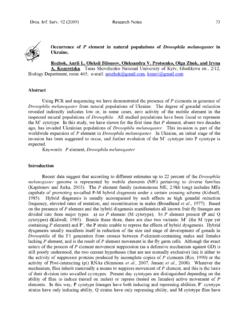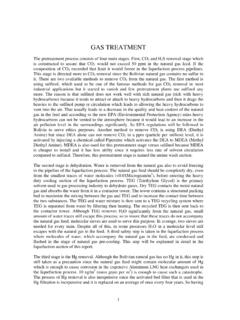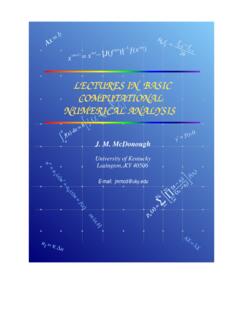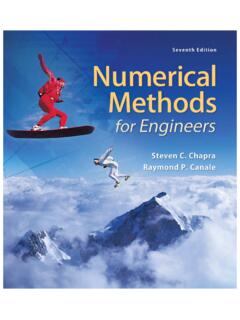Transcription of UNCONSTRAINED MULTIVARIABLE OPTIMIZATION
1 UNCONSTRAINED MULTIVARIABLE OPTIMIZATION .. methods Using Function Values Only 183 .. methods That Use First derivatives 189 .. Newton's Method 197 .. Quasi-Newton methods 208 References .. 210 .. Supplementary References 211 Problems .. 211 182 PART I1 : OPTIMIZATION Theory and methods THE NUMERICAL OPTIMIZATION of general nonlinear MULTIVARIABLE objective func- tions requires efficient and robust techniques. Efficiency is important because these problems require an iterative solution procedure, and trial and error becomes impractical for more than three or four variables. Robustness (the ability to achieve a solution) is desirable because a general nonlinear function is unpredictable in its behavior; there may be relative maxima or minima, saddle points, regions of con- vexity, concavity, and so on. In some regions the OPTIMIZATION algorithm may progress very slowly toward the optimum, requiring excessive computer time.
2 For- tunately, we can draw on extensive experience in testing nonlinear programming algorithms for UNCONSTRAINED functions to evaluate various approaches proposed for the OPTIMIZATION of such functions. In this chapter we discuss the solution of the UNCONSTRAINED OPTIMIZATION problem: Find: that minimizes Most effective iterative procedures alternate between two phases in the opti- mization. At iteration k, where the current x is xk, they do the following: 1. Choose a search direction sk 2. Minimize along that direction (usually inexactly) to find a new point where ak is a positive scalar called the step size. The step size is determined by an OPTIMIZATION process called a line search as described in Chapter 5. In addition to 1 and 2, an algorithm must specify 3. The initial starting vector x0 = [x xs .. n;lT and 4. The convergence criteria for termination. From a given starting point, a search direction is determined, andfix) is mini- mized in that direction.]
3 The search stops based on some criteria, and then a new search direction is determined, followed by another line search. The line search can be carried out to various degrees of precision. For example, we could use a simple successive doubling of the step size as a screening method until we detect the opti- mum has been bracketed. At this point the screening search can be terminated and a more sophisticated method employed to yield a higher degree of accuracy. In any event, refer to the techniques discussed in Chapter 5 for ways to carry out the line search. The NLP (nonlinear programming) methods to be discussed in this chapter dif- fer mainly in how they generate the search directions. Some nonlinear program- ming methods require information about derivative values, whereas others do not use derivatives and rely solely on function evaluations. Furthermore, finite differ- ence substitutes can be used in lieu of derivatives as explained in Section For differentiable functions, methods that use analytical derivatives almost always use less computation time and are more accurate, even if finite difference approxima- CHAPTER 6: UNCONSTRAINED MULTIVARIABLE OPTIMIZATION 183 tions are used.
4 Symbolic codes can be employed to obtain analytical derivatives but this may require more computer time than finite differencing to get derivatives . For nonsrnooth functions, a function-values-only method may. be more successful than using a derivative-based method. We first describe some simple nonderivative methods and then present a series of methods that use derivative information. We also show how the nature of the objective function influences the effectiveness of the particular OPTIMIZATION algorithm. methods USING FUNCTION VALUES ONLY Some methods do not require the use of derivatives in determining the search direc- tion. Under some circumstances the methods described in this section can be used effectively, but they may be inefficient compared with methods discussed in subse- quent sections. They have the advantage of being simple to understand and execute. Random Search A random search method simply selects a starting vector xO, evaluatesflx) at xO, and then randomly selects another vector x1 and evaluates flx) at xl.
5 In effect, both a search direction and step length are chosen simultaneously. After one or more stages, the value of flxk) is compared with the best previous value of flx) from among the previous stages, and the decision is made to continue or terminate the procedure. Variations of this form of random search involve randomly selecting a search direction and then minimizing (possibly by random steps) in that search direction as a series of cycles. Clearly, the optimal solution can be obtained with a probability of 1 only as k + oo but as a practical matter, if the objective function is quite flat, a suboptimal solution may be quite acceptable. Even though the method is inefficient insofar as function evaluations are concerned, it may provide a good starting point for another method. You might view random search as an extension of the case study method. Refer to Dixon and James (1980) for some practical algorithms. Grid Search methods of experimental design discussed in most basic statistics books can be applied equally well to minimizingflx) (see Chapter 2).
6 You evaluate a series of points about a reference point selected according to some type of design such as the ones shown in Figure (for an objective function of two variables). Next you move to the point that improves the objective function the most, and repeat. PART 11: OPTIMIZATION Theory and methods (a) Three-level factorial design (32 - 1 = 8 points plus center) (b) Hexagon design (6 points + center) (c) Two-level factorial design (22 = 4 points plus center) FIGURE Various grid search designs to select vectors x to evaluateflx). For n = 30, we must examine 330 - 1 = X 1014 values of f(x) if a three- level factorial design is to be used, obviously a prohibitive number of function evaluations. CHAPTER 6: UNCONSTRAINED MULTIVARIABLE OPTIMIZATION FIGURE Execution of a univariate search on two different quadratic functions. Univariate Search Another simple OPTIMIZATION technique is to select n fixed search directions (usu- ally the coordinate axes) for an objective function of n variables.
7 Thenflx) is min- imized in each search direction sequentially using a one-dimensional search. This method is effective for a quadratic function of the form because the search directions line up with the principal axes as indicated in Figure However, it does not perform satisfactorily for more general quadratic objec- tive functions of the form as illustrated in Figure For the latter case, the changes in x decrease as the optimum is neared, so many iterations will be required to attain high accuracy. Simplex Search Method The method of the "Sequential Simplex" formulated by Spendley, Hext, and Himsworth (1962) selects points at the vertices of the simplex at which to evaluate f(x). In two dimensions the figure is an equilateral triangle. Examine Figure In three dimensions this figure becomes a regular tetrahedron, and so on. Each search direction points away from the vertex having the highest value offlx) to the other vertices in the simplex.
8 Thus, the direction of search changes, but the step size is PART I1 : OPTIMIZATION Theory and methods FIGURE Reflection to a new point in the simplex method. At point 1, f(x) is greater than f at points .2 or 3. fixed for a given size simplex. Let us use a function of two variables to illustrate the procedure. At each iteration, to minimize f(x), f(x) is evaluated at each of three vertices of the triangle. The direction of search is oriented away from the point with the high- est value for the function through the centroid of the simplex. By making the search direction bisect the line between the other two points of the triangle, the direction goes through the centroid. A new point is selected in this reflected direction (as shown in Figure ), preserving the geometric shape. The objective function is then evaluated at the new point, and a new search direction is determined. The method proceeds, rejecting one vertex at a time until the simplex straddles the optimum.
9 Var- ious rules are used to prevent excessive repetition of the same cycle or simplexes. As the optimum is approached, the last equilateral triangle straddles the optimum point or is within a distance of the order of its own size from the optimum (examine Figure ). The procedure cannot therefore get closer to the optimum and repeats itself so that the simplex size must be reduced, such as halving the length of all the sides of the simplex containing the vertex where the oscillation started. A new simplex composed of the midpoints of the ending simplex is constructed. When the simplex size is smaller than a prescribed tolerance, the routine is stopped. Thus, the optimum position is determined to within a tolerance influenced by the size of the simplex. Nelder and Mead (1965) described a more efficient (but more complex) version of the simplex method that permitted the geometric figures to expand and contract continuously during the search.
10 Their method minimized a function of n variables using (n + 1) vertices of a flexible polyhedron. Details of the method together with a computer code to execute the algorithm can be found in Avriel (1976). Conjugate Search Directions Experience has shown that conjugate directions are much more effective as search directions than arbitrarily chosen search directions, such as in univariate search, or c H A PTE R 6: UNCONSTRAINED MULTIVARIABLE OPTIMIZATION - FIGURE . Progression to the vicinity of the optimum and oscillation around the optimum using the simplex methpd of search. The original vertices are $, xy, and x!. The next point (vertex) is kb. Succeeding new vertices are numbered starting with 1 and continuing to 13 at which point a cycle starts to repeat. The size of the simplex is reduced to the triangle determined by points 7, 14, and 15, and then the procedure is continued (not shown). even orthogonal search directions. Two directions si and sj are said to be conjugate with respect to a positive-definite matrix Q if In general, a set of n linearly independent directions of search so, s1.
















